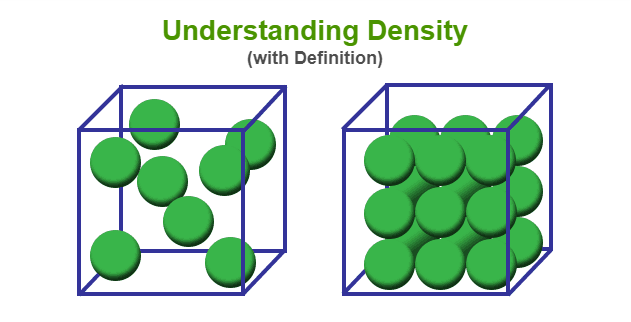Density DefinitionThe mass of a substance per unit of volume is its density. Density is frequently signified by the symbol "?". The density of a particular compound is equal to its larger particles in numbers. Density varies widely among materials and might be important for wrapping, cleanliness, and stability. A substance's density changes as a function of pressure and temperature changes. With respect to different substances, such variation in density is often measured as a minimum; however, this may be too much for vapor. The density is also known by some other names, such as volumetric mass density or specific mass. 
A loss in volume with the subsequent rise in density occurs when increasing pressure is applied to a material. A material's density is decreased, and the subsequent volume is increased when increasing the amount of heat (temperature) applied to a material. It is occasionally substituted by non-dimensional terms like "relative density" or "specific gravity", which is the ratio of the denseness of the substance to that of a standard sample, typically water, to make density measurements between multiple systems easier. Measurement of DensityThere are numerous methods and criteria for calculating a substance's density. These methods include pouring or tapping, using a hydrometer, a hydrodynamic balancing, a dipped object way, a measuring cylinder, an air comparability measuring cylinder, and a pycnometer. Each approach helps to measure the specific type of density. So, let us understand some of the major types of density: Homogeneous SubstancesA homogeneous substance has a concentration identical to its total mass divided by overall volume capacity in any place. The capacity can be calculated analytically or from the movement of a liquid, while the mass is often calculated using a scale or balance. The hydrometer, dasymeter, and Coriolis flow meter can be employed to measure the overall density of the substances like fluid or vapor, correspondingly. Non-Compact MaterialsVoids are areas where no substance is being addressed. Although air is typically emptiness, it might also be a suction, fluid, solid, or gaseous composition. It is common to use precise measuring or a mathematical calculation based on known parameters to determine the heavy volume of a substance, including the vacancy fraction. It should determine the mass of the test piece carefully in non-compact substances. According to how it originally made the measuring, buoyancy effects caused by the volume of the empty component could have to be considered when determining the mass of a substance when it is under compression. Heterogeneous SubstanceThe volume of the substance will differ in various parts of the thing if it isn't uniform. Within this situation, the densities of a tiny volume surrounding a certain point are used to calculate the density there. Unless it can accurately determine the variation in density between the 2-void substances, the mass shift that results from replacing 1-void substance might utilize another before retaining a fixed volume to calculate the void fraction. SI UnitTypically, the normal unit of density in CGS is gram per cubic centimeter (g/cm3). Meanwhile, a kilogram per cubic meter (kg/m3) is the unit used to quantify density there in the SI system. The formula for finding the unit of density is: ? = m/V Where "?" denotes density, "m" denotes mass, and "V" denotes volume. Change of DensityIn theory, increasing the pressure or the heating rate will alter the density. The density of a substance constantly rises as the pressure does. There are many noteworthy exceptions to the universal rule that density reduces as heat increases. The concentrations of fluidand solids are only slightly affected by heatand pressure. A normal fluid or substance has a compressibility of 10^-6 bars^-1 and a thermal expansivity of 10^-5 K^-1. The density of an ideal gas is: ? = M*P/R*T Where "?" denotes density, "M" denotes the mass of substance, "P" denotes pressure, "R" denotes a universal gas constant, and "T" denotes absolute temperature. Effects of Temperature on DensityAll materials have a propensity to spread upon heating, resulting in a similar mass occupying a higher quantity and decreasing the density. Although it is not insignificant, this growth is often smaller, like most materials, compared to that of liquids. Applications in Real Life
Next TopicDialysis Definition
|
 For Videos Join Our Youtube Channel: Join Now
For Videos Join Our Youtube Channel: Join Now
Feedback
- Send your Feedback to [email protected]
Help Others, Please Share









